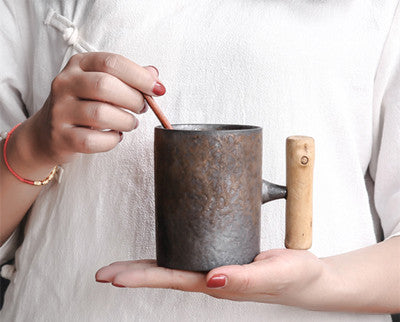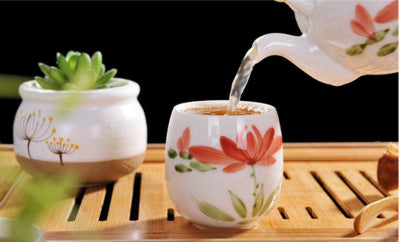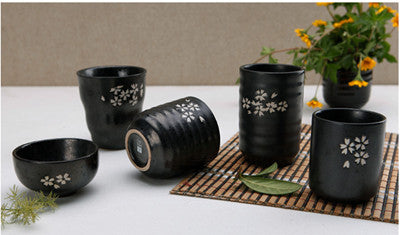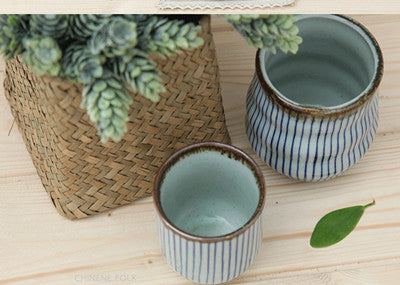Buy Genuine Japanese Tea Cups from Japan
Japanese Tea Cups
If you are an avid tea lover and fond of Japanese culture and traditions, you'll appreciate the artistry and craftsmanship behind a simple yet elegant Japanese tea cup.
Tea ceremonies are of utmost significance in Japanese culture and tradition, featuring tea cups that are relatively small and simple. Authentic teacups are based on the concept of "imperfection" with asymmetrical design and plain texture.
By the end of the article, you will know what Japanese tea cups are and the different types based on the pottery style and material used. We have also discussed some popular tea ceremonies and key differences between Chinese and Japanese tea cups to help you make a more confident selection.
Let's dive into the details!

What are Japanese Tea Cups?
In Japan, people tend to relate to Japanese tea cups when talking about Japanese tea sets. Clearly, Japanese tea cups is a kind of important tea sets. When people first see Sencha making, they are always astonished at the small size of the tea cup and few tea in it. It is common sense for Sencha-making people in Japan that they shall be devoted to small size and exquisiteness, which shows the unique characteristics for making Sencha at that time. There are plenty stories about why choosing small cups. Some say it is because only small cups were available and commonly-used at that time, while others content that it was affected by Chinese Kongfu tea making.
Tea drinking has become a tradition in Japan over the years, and Japanese tea cups has become known around the world. There is vast collection of Japanese tea cups suitable for various occasion. And to fully appreciate and enjoy the tea, we recommend Japanese tea cups. If you are tea lover, with these antique Japanese tea cups are a smart choice. These Japanese tea cups will also add a unique cultural accent to your home.
Nothing makes us happier than great design...Except great tea and tea cups, of course. Which is why we’re so jazzed about this bright, modern collection of tea cups. Clean and sleek with colourful accents, they just make us smile.
Japan is famous for hosting tea ceremonies on different occasions including intimate gatherings or big events. The immaculate artistry and craftsmanship of Japanese teacups are a standout feature of the country's centuries-old tea culture.
To fulfill the requirements of tea ceremonies and to enjoy tea gatherings to the fullest, Japanese people invest their time and money to choose the right teacup that suits their needs.
Japanese tea cups are designed with unique style and exquisite details that enchant the eyes of tea consumers. These Japanese tea cups are sold in different shapes and sizes, varying from small chawan to large matcha bowls.
Some Japanese tea cups, such as yunomi, are ideal for daily use by tea lovers. In contrast, chawan or big-size Japanese tea cups are used in tea ceremonies. Similarly, Japanese tea cups also differ based on the type of material used. Each teacup has a unique production style, properties, and features, giving you an exceptional experience every time you drink tea in these tea cups.

The Feature of Japanese Tea Cups
1. The Beauty of Simplicity. The beauty of simplicity is one of the basic elements of Japanese tea ceremony culture. Therefore, most of the Japanese tea cups we see now are often simple. Although they seem to be unencumbered, they have a simple beauty, which let you unforgettable.
2. The Beauty of Nature. Unintentional, unconscious. Whether it is a tea master or a tea guest, in the tea room, when they look at each other with deep courtesy and respect, the common mentality they show is the beauty of nature. In the Japanese tea ceremony culture, the deliberate behavior that regards not beautiful. Therefore, from tea to human behavior, all pursue the natural state. So the best tea cups is made by coarse pottery naturelly.
3. Calm, quiet, peaceful and self reflection in our daily life is also one of the elements of Japanese tea ceremony culture The beginning and end of the tea ceremony are often done in a silent silence. The theme of Japanese tea cups is quiet. The beauty of silence in Japanese tea ceremony is also integrated into the tea cup.
4. When we look at Japanese tea cups, what we notice is not how delicate and practical it is. What really moves us is that it is a kind of simple and temperament, which is mixed with different styles of ancient and modern times. The preservation and development of this ancient style is one of the aesthetic sources of Japanese tea cups. The temperament not only comes from the outside, but also from the inside, just like the spirit of Japanese craftsmen that we know. In Japan, many workshops are small and not factory level. Even the number is far lower than the Chinese master studios. However, a small number of people also brings benefits. No matter how famous the masters are, they all do it by themselves. In this way, these tea cups will have a strong personal style. His temperament, his experience, his understanding and cognition of tea are all in it. Using his cup is equivalent to talking with him.

Types of Japanese Tea Cups
Japanese people are very particular about choosing a teacup; hence, there is a vast collection of Japanese tea cups for every tea occasion. The following explains a few common types:
Yunomi
Simple yet classic, yunomi tea cups are a must-have for every tea lover. In Japanese, the term Yunomi means drinking hot water. Yunomi tea cups are upright, tall, and mostly used for drinking hot water.
These teacups have a cylindrical body, curved foot, and narrow mouth. Yunomi tea cups are mostly used for informal tea gatherings. These Japanese tea cups have no handles, offering a warm and joyful tea experience.
Some yunomi tea sets are sold in pairs, popularly termed Meoto yunomi, meaning married couple. Yunomi tea sets have been manufactured since the 1500s, and they are of different types based on pottery style.
Hagi
Hagi yunomi is one of the oldest Japanese teacups, originally crafted in the Hagi city of Yamaguchi Prefecture. These Japanese teacups have a Korean influence, evident in their glazing style.
Karatsu
Karatsu teacups are originally from Karatsu of the Saga Prefecture and are made using high-firing processes and glazing. These types of Japanese teacups have an underlying iron base coated with brush-applied designs on their surface.
Shino
Shino yunomi tea cups were the first original white glazing style Japanese tea cups. These teacups have oxide markings that add color and texture to the cup. Moreover, small pin-sized holes throughout the cup make them appear unique and different.
Mashiko
The name "Mashiko" originated from a town called Mashiko, where these teacups were traditionally crafted. Mashiko is famous for its red-brown color (the color of the clay used) and rustic design. Over the years, these Japanese tea cups have been reformed and changed into different colors.
Wabi Sabi
Wabi-sabi is a popular Japanese phrase that means imperfect beauty, with the concept of celebrating and embracing natural imperfections. In the teaware world, it was first captured by Rikyu, the tea master in Japan. Wabi-sabi is more like an artistic style than a pottery type. These Japanese tea sets are asymmetrical, unique, and imperfect but have their style and beauty.
Chawan
Traditional chawan tea cups are big, almost the size of a bowl, and used to prepare and drink tea. Chawan matcha bowls are handmade tea bowls crafted using clay.
These Japanese teacups have a thick wall and no handle. The thick wall helps retain heat, and the handle-less design keeps your hand warm while enjoying tea sessions. Chawan tea cups look like a typical bowl and are reserved for ceremonial purposes.
These teacups have a broad base, a relatively cylindrical structure, and a wide mouth. This design ensures easy whisking of the matcha tea, and the steeper sides prevent the tea spillage during whisking.
Ceramic
In addition to the types of Japanese tea cups based on history and pottery style, the medium used to make these teacups also differs.
Ceramic-style Japanese tea cups are made using raw clay. They are heated under high temperatures and refined to form different shapes. The heat then tells how thick or porous the finalized product will be.
Earthenware
The origin of earthenware dates back to the dawn of civilization. Earthenware includes raw clay and other ceramic materials that are heated and crafted into soft, porous, and more refined ceramic tea cups. They have a wide variety of shapes, colors, and decorations. These materials are glazed or enameled to create a water-resistant surface and exquisite finish.
Stoneware
These Japanese tea cups are fired at heated temperatures, producing a dense material with fewer pores and a smooth finish. Stoneware tea cups have exceptional heat-retaining properties. Complementing materials like quartz or feldspar are added to make them more durable and enhance glaze and heat retention quality. Moreover, the tough material makes them crack-proof, microwave, and dishwasher-safe.
Porcelain
Porcelain teacups are a type of ceramic-style material fired at extremely high temperatures. These Japanese tea cups are pure white, with a sophisticated appearance and smooth texture. Porcelain teacups have a neat outlook and are cherished for their lightweight and durable material. The best part about these Japanese tea cups is that the material is non-porous. Hence, it doesn't leave any stains or long-lasting odor, and you can always enjoy the sweet aroma of your tea.
Wooden
Among various teaware collections, wooden teacups are adored for their simplicity and almost natural texture. These tea cups are sold with a wooden saucer and spoon that completes the whole tea set.
Glass
Some newer and more advanced Japanese tea cups are made using glass as a core medium. Glass tea cups are cherished for their transparency and clear view while the hot tea is brewed. The beautiful and artistic dance of tea leaves inside the glass teacup appeals to a tea lover and enhances the overall tea experience in a gathering.

Difference Between Japanese Tea Cups And Chinese Tea Cups
As much as tea culture is enjoyed in Japan, the Chinese have a long history and tradition of tea ceremonies and rituals. But some cultural differences set them apart.
Learning about the historical background and distinct features of Japanese and Chinese tea cups is important if you are a tea lover and a perfectionist in tea etiquette.
Teaware Material
The craftsmanship of both these countries is different but stunningly beautiful. Chinese tea cups are usually made using porcelain, which has a delicate appearance and increased durability. Jingdezhen and Dehua are well known for producing porcelain.
In comparison, Japanese tea cups mostly have earthenware or iron bases glazed with plain textures. Most Japanese tea masters use raw clay or ceramic-style material to create simple and elegant teaware.
Styles & Designs
One of the most notable differences is in style and design. You must have noticed the bold colors used to make Chinese tea sets compared to Japanese tea cups that embrace more natural and muted colors.
Moreover, some Chinese tea cups have symbolic animals, such as dragons, printed on them. In contrast, Japanese tea cups have minimal to no printing with soft textured glazes in a monochromatic base. Lastly, Chinese tea cups are more symmetrical and simple, while Japanese tea cups are asymmetrical and imperfect.
Ceremony Traditions
The type of tea and cultural ceremonies also vary in both these regions based on which versions of the teacups are used. The famous Chinese ceremony Chinese gongfu aims at achieving a perfectly balanced cup of tea. It focuses more on the flavors and delicacy of tea. Therefore, Yixing clay tea cups are preferred most.
The popular Japanese tea ceremony "chanoyu" or "sado" has a deep spiritual meaning and background. This ceremony is highly ritualized and takes place in a tranquil setting in which specific protocols and movements are followed to serve matcha. Chawan bowls and cups are preferably used to fulfill the purpose of this tea ceremony.

Why Most of the Japanese Tea Cups Has No Handles?
In daily life, the water cup, coffee mug or office cup used for drinking water with handles, which are convenient for people to use. But why do Japanese tea cups have no handles?
This is because when drinking Japanese tea, the best temperature is 60 ℃, which is suitable temperature when holding the tea cup in your hand. The most intuitive feeling is that you can taste the best taste of Japanese tea at this time. Therefore, most Japanese tea cups will not set the handle for better experiencing this feeling.
Sum Up
So that was all about Japanese rituals and special tea cups used for Japanese gatherings and ceremonies. We recommend you invest in Japanese tea cups if you love Japanese culture and its traditions and wish to own a good collection of Japanese tea sets. Umi Tea Sets offer some valuable products, and almost all Japanese tea cups are available on the website.
This website's teaware collections are authentic and purchased directly from Japan. These products are a holy grail for those fascinated by Japanese culture and art. Afterall,it is not merely about enjoying the tea ceremony but also about learning etiquette and nourishing cultural values.